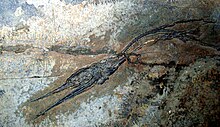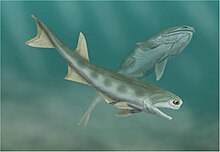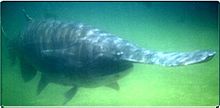Cartilage organoids
| Cartilage organoids | ||||||||||||
|---|---|---|---|---|---|---|---|---|---|---|---|---|

Sternhausen ( Acipenser stellatus ) |
||||||||||||
| Temporal occurrence | ||||||||||||
| Middle Devonian or Triassic to this day | ||||||||||||
| Locations | ||||||||||||
|
||||||||||||
| Systematics | ||||||||||||
|
||||||||||||
| Scientific name | ||||||||||||
| Chondrostei | ||||||||||||
| Müller , 1844 |
The cartilaginous organoids (Chondrostei = "cartilage ossicles") are primitive bony fish (Osteichthyes) and form a subclass of the ray fins (Actinopterygii). They get their names from their cartilage skeleton , which is only slightly ossified, and the ganoid scales that partially or completely cover their skin. Because of the structure of their paired fins, they are compared (as "Palaeopterygii") to all other ray fins or Neopterygii . The sturgeon-like (Acipenseriformes) are the only recent fish order that is counted among the cartilage organoids. In addition, numerous extinct fish groups have been and are still being placed in the cartilage organoids in rather conservative systems.
Fishes with a cartilaginous skeleton and ganoid scales can be found in fossils from the middle Devonian onwards. They were the dominant group of bony fish from the Carboniferous to the end of the Triassic .
features
Characteristic of the animals belonging to the Chondrostei are the skull structure (the upper jaw is not steered directly on the neurocranium ), the possession of an injection hole (in most cases), the ganoid scales, a heterocercal tail fin with ganoid keel scales (fulcres) on the upper edge and the dense arrangement of the fin rays . The interopercular (an element of the gill cover ) is missing.
Conventional system
The monophyly of the chondrostei in its old composition, as well as the lower taxa, is controversial. The American ichthyologist Joseph S. Nelson puts in his standard work on fish systematics Fishes of the World , the following orders in the cartilage organoids:

- Cheirolepidiformes †
- Guildayichthyiformes †
- Palaeonisciformes †
- Tarrasiiformes †
- Phanerorhynchiformes †
- Saurichthyiformes †
- Sturgeon (Acipenseriformes)
- Ptycholepidiformes †
- Pholidopleuriformes †
- Perleidiformes †
- Luganoiiformes †
In this composition, however, the cartilaginous organoids are a paraphyletic group as they do not include all descendants of the youngest common ancestor.
Phylogenetic systematics
In the following cladogram from a current palaeontological textbook, the cartilage organoids are largely resolved and only the Birgeriidae remain as an extinct sister group of the sturgeon alongside these within the now monophyletic cartilage organoids


| Ray fins |
|
|||||||||||||||||||||||||||||||||||||||||||||||||||||||||||||||||||||||||||||||||||||||||||||||||||
|
|
literature
- Joseph S. Nelson : Fishes of the World , John Wiley & Sons, 2006, ISBN 0-471-25031-7
- Michael J. Benton : Paleontology of the vertebrates. Translation of the 3rd English edition by Hans-Ulrich Pfretzschner. Pfeil, Munich 2007, ISBN 978-3-89937-072-0 .
Individual evidence
Web links
- Palæos: Chondrostei

